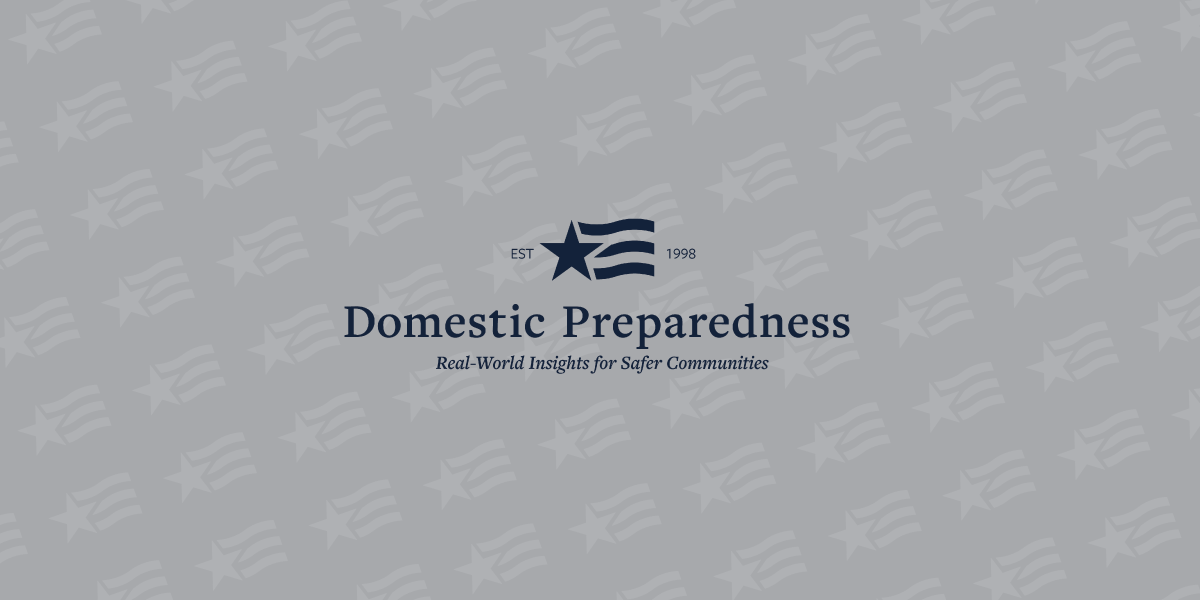- Agriculture & Food Defense, Articles, CBRNE, Emergency Management, Emergency Medical Services, Hazmat, Hospitals, Law Enforcement, Public Health, Terrorism, Transportation
- Raphael M. Barishansky
The seemingly obvious phrase “public health emergency” is in fact one of the most frequently misunderstood terms in the emergency management lexicon. Individual states may declare a statewide public health emergency with or without a federal declaration and, by doing so, would allow the states themselves to: (a) purchase and distribute additional antivirals and personal protective equipment; (b) communicate directly and more freely with local public health officials, healthcare providers, other state and federal agencies, and private partners; and (c) allow a broad spectrum of state agencies and departments to implement various plans to deal with such emergencies. This is, in fact, what happened during the 2009-2010 H1N1 pandemic when various states – including Virginia, California, and Texas – declared public health emergencies.
Under Section 319 of the Public Health Services Act (42 U.S.C. § 247d), the Secretary of the U.S. Department of Health and Human Services (HHS) may declare a federal public health emergency if the Secretary determines, after consultation with other public health officials, that “(1) a disease or disorder presents a public health emergency; or (2) a public health emergency, including significant outbreaks of infectious diseases or bioterrorist attacks, otherwise exists.” This broad definition gives HHS the discretion, therefore, to determine if a particular event does in fact constitute a public health emergency. If that determination is made, the declaration lasts for 90 days, but can be terminated earlier if the Secretary determines that the emergency no longer exists. If the emergency persists, though, the determination may be renewed for an additional 90 days.
The conditions leading to these declarations include, but are not necessarily limited to, any of the following dangers or situations: contaminated flood water; compromised sewage treatment plants; unsafe drinking water; carbon monoxide poisoning; food poisoning; and/or mold caused by flooding. The HHS Secretary also has the discretion to determine that a specific disease or condition presents a public health emergency, and/or that a public health emergency otherwise exists because of conditions that were present prior to a natural catastrophe or the actual outbreak of a disease.
Impacts of a Public Health Emergency Declaration
Events that constitute a public health emergency declaration can potentially overwhelm existing healthcare resources – hospitals and nursing homes, for example, as well as dialysis centers and EMS (emergency medical services) agencies. The declaration provides, among other things, state healthcare systems more flexibility in assisting crisis victims and permits Medicare patients to receive care at nursing homes without the normally required three-day hospital stay.
Under Section 1135 of the Social Security Act (42 U.S.C. § 1320b-5), the HHS Secretary also may temporarily waive or modify certain Medicare, Medicaid, and/or CHIP (Children’s Health Insurance Program) requirements to ensure that: (a) sufficient healthcare material resources, and services, are available to meet the needs of people in the emergency area and time periods; and (b) the providers of such services, in good faith – i.e., absent any determination of fraud or abuse – can be reimbursed and exempted from sanctions. Section 1135 also lists various requirements that can be waived or modified – e.g., revising bed limits for hospitals – to help states expand their surge capacities. When the Secretary issues an 1135 waiver, hospitals and other healthcare facilities usually work directly with the HHS’s own Regional Centers for Medicare and Medicaid Services (CMSs) to seek specific waivers or modifications on a case-by-case basis.
Among the most frequent examples of the circumstances governing when, and why, 1135 waivers or modifications are issued are the following:
- Requirements that physicians and other healthcare professionals be licensed in the state in which they are providing services – provided, however, that they (the physicians and other healthcare professionals) have equivalent licensing in another state. (This waiver is for purposes of Medicare, Medicaid, and CHIP reimbursement only – state laws determine whether a non-federal provider is authorized to provide services in the state without state licensure);
- The imposition of Emergency Medical Treatment and Labor Act (EMTALA) sanctions for the direction or relocation of an individual to receive a medical screening examination in an alternative location pursuant to an appropriate state emergency preparedness plan – or, in the case of a public health emergency involving pandemic infectious disease, a state pandemic preparedness plan. Also for the transfer of a patient who has not been stabilized if the transfer is necessitated by the circumstances of the declared emergency (a waiver of EMTALA requirements is effective only if the actions authorized under the waiver do not discriminate on the basis of a patient’s source of payment or ability to pay); and
- Limitations that have been imposed on payment for healthcare items and services furnished to Medicare Advantage enrollees by non-network providers.
Floods, Pandemics & Superstorms
The March 2009 Red River flood experienced in North Dakota required a public health emergency declaration (issued under section 319 of the Public Health Service Act). That flood also served, not incidentally, as a prime example of the unfortunate fact that, even with weeks of advance warning, preparation activities still may not be enough to hold back the river, which crested at 23 feet above the flood stage – the second highest level recorded over the past 150 years. It took more than a month, in fact, for the Red River to show signs of receding, which also put an immense burden on the local infrastructure and created a variety of public health concerns – involving and/or related to, for example, environmental health, the outbreak of communicable diseases, and numerous other dangers and difficulties. Similar once-per-century natural disasters, of course, could occur in almost any state or city in the country, and it would be extremely difficult – exorbitantly expensive, as well – to fully and effectively prepare for such rare occurrences.
A public health emergency declaration was made in 2009-2010 by HHS in response to the H1N1 pandemic. Millions of doses of Tamiflu were distributed from the Strategic National Stockpile (SNS) to locations where states could quickly access them as needed. In addition to the public health emergency declaration, President Obama declared a national emergency, which encouraged U.S. businesses to take certain preparedness actions on their own – by, for example, informing and educating their employees on how to help stop the spread of the flu and develop business continuity-of-operations plans.
The fact that the H1N1 pandemic was declared both a national emergency and a public health emergency not only helped to ensure that the medical resources needed to fight the disease were available to states and local communities, but also led to follow-on long-term planning initiatives at all levels of government and in the private sector. This sequence is similar to how the anthrax letter mailings in 2001 (shortly after the 9/11 terrorist attacks) led to a permanent change in the public health emergency preparedness landscape and focused significant public health resources on the advance planning needed to cope with biological attacks of any type in the future.
More recently, Superstorm Sandy wreaked havoc on several East Coast states in late October 2012, causing an estimated $50 billion or more in property damage and precipitating a national public health emergency declaration (primarily, though, for New York and New Jersey). That declaration was made by the HHS Secretary, working in close coordination with the White House, and permitted some of the exemptions mentioned earlier to be made to the healthcare systems in the affected states.
The Future of Public Health Emergency Declarations
Past events demonstrate that public health declarations can and are being made during natural disasters and/or other “non-traditional” public health events. In the future, there are likely to be even more declarations of public health emergencies, the ramifications of which will continue to have a major impact on the nation’s healthcare and public health infrastructure, particularly in regards to the resources available, the costs incurred, staffing requirements, and various other factors.
Recent developments in public health emergency preparedness (PHEP) include the promulgation, by the U.S. Centers for Disease Control & Prevention (CDC), of Public Health Preparedness Capabilities, as well as the alignment of the CDC’s own PHEP (Public Health Emergency Preparedness) and HPP (Hospital Preparedness Program) grants.
In the short term, these recent changes represent an encouraging move toward a better understood and more closely coordinated era of public health preparedness with clear goals and objectives. The same developments also have allowed federal, state, and local public health agencies to better organize their work, plan their priorities, and decide which capabilities they are able to build or sustain with current resources. The total long-term effects of these moves, however, have yet to be seen.
____________
For additional information on: EMTALA Implementation and Enforcement Issues, visit https://www.gao.gov/products/gao-01-747
The Public Health Services Act (42 U.S.C. § 247d), visit https://web.archive.org/web/20090103141709/http://uscode.house.gov/download/pls/Title_42.txt
Section 1135 of the Social Security Act (42 U.S.C. § 1320b-5), visit https://www.ssa.gov/OP_Home/ssact/title11/1135.htm
Significant contributions to this article were made by Audrey Mazurek, a senior associate at ICF International and a public health preparedness planner for the Prince George’s County and Montgomery County (Maryland) Health Departments. She also serves as an adjunct analyst at the Homeland Security Studies and Analysis Institute (HSI). Prior to assuming those positions, she was a program manager at the National Association of County and City Health Officials (NACCHO).

Raphael M. Barishansky
Raphael M. Barishansky, DrPH, is a public health and emergency medical services (EMS) leader with more than 30 years of experience in a variety of systems and agencies in positions of increasing responsibility. Currently, he is a consultant providing his unique perspective and multi-faceted public health and EMS expertise to various organizations. His most recent position prior to this was as the Deputy Secretary for Health Preparedness and Community Protection at the Pennsylvania Department of Health, a role he recently left after several years. Mr. Barishansky recently completed a Doctorate in Public Health (DrPH) at the Fairbanks School of Public Health at Indiana University. He holds a Bachelor of Arts degree from Touro College, a Master of Public Health degree from New York Medical College, and a Master of Science in Homeland Security Studies from Long Island University. His publications have appeared in various trade and academic journals, and he is a frequent presenter at various state, national, and international conferences.
- Raphael M. Barishanskyhttps://domprep.com/author/raphael-m-barishansky
- Raphael M. Barishanskyhttps://domprep.com/author/raphael-m-barishansky
- Raphael M. Barishanskyhttps://domprep.com/author/raphael-m-barishansky
- Raphael M. Barishanskyhttps://domprep.com/author/raphael-m-barishansky






